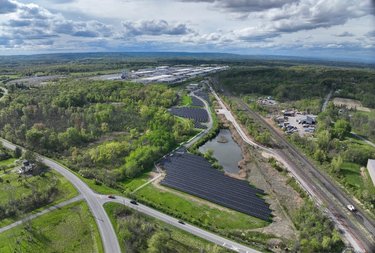Solar facility rises on site of old Army burn pit
GUILDERLAND — A community solar facility now covers part of what used to be a polluted burn-pit area left by the old Army depot.
The 2.8-megawatt facility will provide energy to over 260 New York households and anchor subscribers in National Grid’s utility territory, according to Nautilus Solar Energy, which developed the site.
The project was started in 2021 by Cipriani Energy.
At the time, Cipriani’s Chief of Operations Officer Christopher Stroud said, “What we’re attempting to do here is utilize as much of the capped landfill area as a redevelopment project as possible. So that’s why we’ve obviously respected the 100-foot setback for the wetlands. With area variances, it’s more with regard to making maximum use of that landfill cap to redevelop that site.”
In 2022, Nautilus announced the acquisition of two community solar portfolios in New York state from Cipriani Energy, including the one in Guilderland as well as another in Oswego.
“We don’t disclose prices,” Carlene Pruitt, a spokeswoman for Nautilus, told The Enterprise when asked about the cost of the acquisition.
The “fully remote” Nautilus Solar Energy is headquartered in New Jersey, with over 30 projects in New York, Pruitt said.
“Across the country,” she said, “we have over 250 projects in operation and more in various stages of development.” In addition to New York and New Jersey, Nautilus has projects in eight other states: California, Colorado, Delaware, Maine, Maryland, Massachusetts, Minnesota, and Rhode Island.
Nautilus, founded in 2006, is owned by Power Sustainable, a wholly owned subsidiary of Power Corporation of Canada.
While Guilderland’s is the first facility Nautilus has built on a Formerly Used Defense Site, Pruitt said, “We always try to look for land that is unusable … So we’ve developed on Superfund sites, on landfills; we’ve developed on gravel pits.”
In Maine, she said, Nautilus built a solar facility on “a little sliver of land” between two highways that’s “not developable for anything.”
“So we really try to be conscious and find those projects that, you know, kind of take an environmental eyesore and turn it into something much more productive,” she said.
The Army depot in Guilderland was set up in 1941 as a storage center for the military during World War II; it was used through the 1960s. The Army diverted the Black Creek into two halves, and sent waste into the creek or buried it on site. Some of the debris left by the Army was hazardous.
The local depot had nine areas of concern, or AOCs, which the Army classified as having a risk to human health.
For years, Gregory Goepfert, project manager for the Army Corps, worked with a local Restoration Advisory Board to identify the toxic waste on land now largely part of the Northeastern Industrial Park and secure funds for clean-up. Several of the areas were cleaned up and others remediated.
In building the solar facility, care was taken not to disturb the land, Pruitt said. “We have to be very conscious and mindful when it comes to the production or development of projects like this,” she said. “We can’t drill, you know, like pilings into the dirt.
“So what we do is we use a ballast system — they look kind of like cinder blocks — to hold the racking and the panels on top of the soil so there’s no penetration of the soil whatsoever.”
The project generated 100 local jobs during the development stage, Pruitt told The Enterprise, and will create a dozen new permanent jobs for ongoing maintenance, landscaping, and engineering.
The environmental impact of this project, the company says, is equivalent to the carbon sequestration of 43,000 trees and offsets the annual carbon emissions produced by over 600 cars.
The state’s Climate Leadership and Community Protection Act requires 70 percent of New York’s electricity to come from renewable sources by 2030 and also stipulates that at least 35 percent of the benefits of clean energy investment are directed to disadvantaged communities and low-to-moderate income subscribers.
Residents can subscribe to the community solar facility at a discount to the standard electric service rate. The company’s website, nautilussolar.com, has information about subscribing.
“It’s free to subscribe and they get a discount of 10 percent off of their electric bill in the form of solar credits,” Pruitt said of subscribers. “It’s kind of like a win-win. Nothing changes. And in New York, it’s consolidated billing so they won’t even get a bill from us — it’ll be directly on their local utility bill and they just see the savings right there.”



